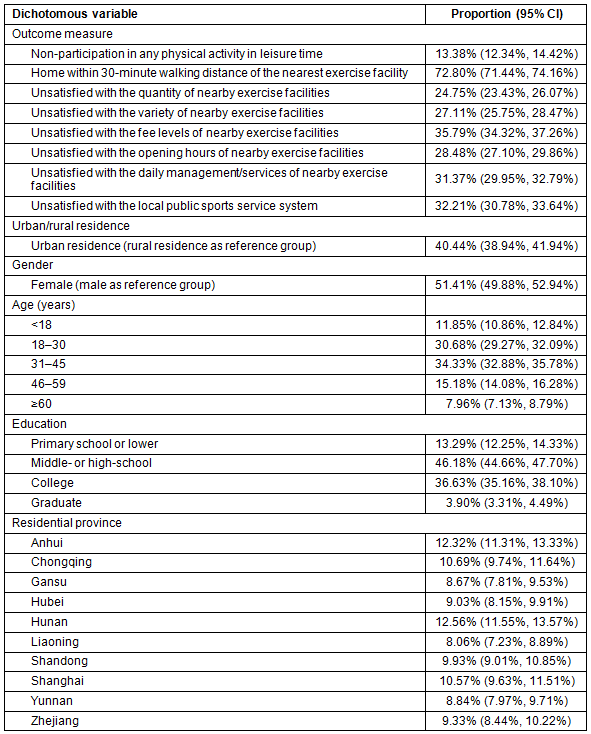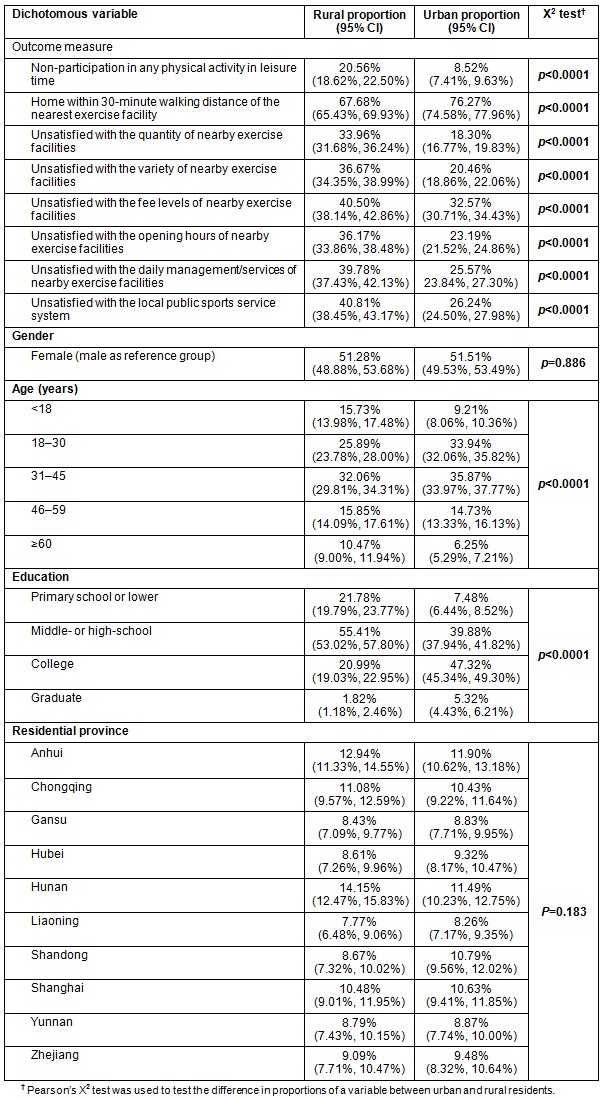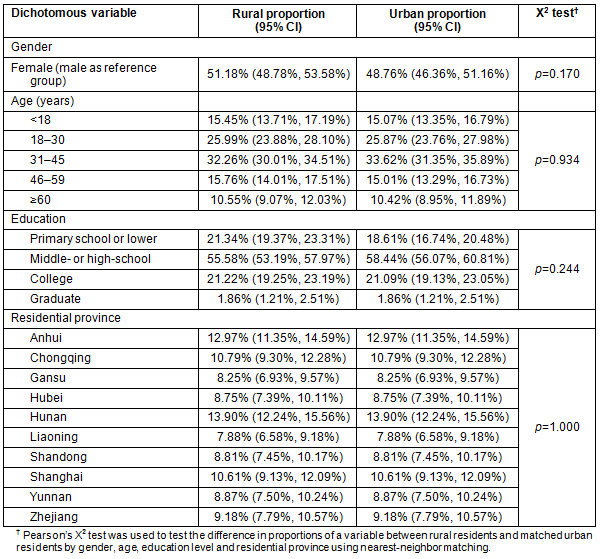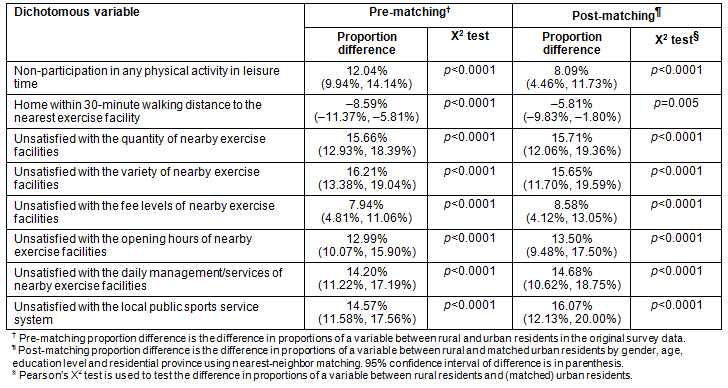The widening rural-urban inequalities have been a prominent issue in China over the past few decades and profoundly impact the transitioning society from planned to market economy1. Compared to their urban counterparts, Chinese rural residents are disadvantaged in multiple domains such as employment and wage2,3, education4,5, health care6,7 and public infrastructure8,9. Disparities in socioeconomic factors are hypothesized to contribute to the increasing gap in health behaviors and outcomes between the rural and urban population10-12.
Physical activity is a key component for a healthy lifestyle and reduces the risk of many adverse health outcomes such as coronary heart disease, type 2 diabetes, and breast and colon cancers13. Compared to the urban population, rural residents may encounter various barriers to gaining equal opportunities to effectively engage in physical activity, including financial strain, lack of relevant knowledge, shortage of exercise resources, and inadequate recreational sports and fitness services. A few studies have examined the relationship between neighborhood environment and physical activity in China14-17. However, these studies typically have limited geographical coverage (eg in one city), small sample size (up to a few hundred), and homogenous subjects (eg older urban residents only). To the authors' knowledge, no study has investigated the rural-urban disparities pertaining to local exercise facilities in China.
This study examines the differences in leisure-time physical activity, proximity to the nearest exercise facility, and satisfaction level with nearby exercise facilities and the public sports service system between Chinese rural and urban inhabitants. Data came from a recent cross-sectional survey conducted in 29 counties of 10 provinces.
Study sample
The study sample came from a cross-sectional survey conducted by the Shanghai University of Sport during October-December 2012. The survey covered all three regions in China: four provinces including Liaoning, Shandong, Shanghai and Zhejiang in the East; three provinces including Anhui, Hubei and Hunan in the Central; and three provinces including Chongqing, Gansu and Yunnan in the West. Within each province, two to six counties with medium economic development level (based on per-capita gross domestic product in a province) were selected, and within each county two to four urban districts or one or two rural villages were randomly chosen. Trained interviewers were sent to each district/village to administer the survey. Survey opportunity was advertised in local media outlets and open to all residents in the district/village. Participation was voluntary; a gift was offered upon receipt of the completed questionnaire. A total of 5000 questionnaires were distributed (3000 to urban residents and 2000 to rural residents). In urban districts, 2532 questionnaires were returned among which 2446 were validated; in rural villages, 1784 questionnaires were returned among which 1661 were validated. Statistical analyses were performed on the validated sample of 4107 responses.
Outcome measures
Eight outcome measures were used, pertaining to physical activity, proximity to exercise facility, satisfaction level with the quantity, variety, fee levels, opening hours, and daily management and services of the exercise facility, and satisfaction level with the local public sports service system. These were:
- a dichotomous variable for non-participation in any leisure-time physical activity, corresponding to the answer of 'never' to the survey question 'How often do you do physical exercise in your leisure time? More than 3 times a week, 1-3 times a week, occasionally, or never.'
- a dichotomous variable for living within a 30-minute walking distance from home to the nearest exercise facility, corresponding to the answer of 'within 10 minutes' or '10-30 minutes' to the survey question 'How long does it take to walk to the nearest exercise facility? Within 10 minutes, 10-30 minutes, 30-60 minutes, or more than 60 minutes.' (The typical preferred walking speed is 1.4 meters per second, and a 30-minute walking distance approximately corresponds to 1.5 US miles18.)
- six dichotomous variables for being unsatisfied with the quantity of nearby exercise facilities, variety of nearby exercise facilities, fee levels of nearby exercise facilities, opening hours of nearby exercise facilities, daily management and services of nearby exercise facilities, and local public sports service systems, corresponding to the answers of 'disagree' or 'strongly disagree' to their respective five-point Likert survey questions.
Sociodemographics
The following sociodemographic variables were used for matching rural and urban residents:
- a dichotomous variable for female (with male in the reference group)
- four dichotomous variables for age group (18-30 years, 31-45 years, 46-59 years, and 60 years and older, with younger than 18 years in the reference group)
- three dichotomous variables for education level (graduate school education, college education, and high- or middle-school education, with primary school education or lower in the reference group)
- nine dichotomous variables for residential province (Anhui, Chongqing, Gansu, Hubei, Hunan, Liaoning, Shandong, Shanghai, and Yunnan, with Zhejiang in the reference group).
Statistical analyses
Matching is a commonly used statistical procedure to address potential confounding issues in observational data. The goal of matching is to obtain similar covariate distributions between the two or more groups in comparison by pairing study subjects with alike characteristics. Nearest-neighbor matching is a non-parametric estimator to match individuals in one group with their nearest 'neighbor(s)' (smallest distance) in the comparison group19,20. In this study, the Mahalanobis distance is adopted, in which the weights for distance calculation are based on the inverse of the covariates' variance-covariance matrix. A one-to-one matching is performed: each rural resident is matched with his or her urban counterpart who has the smallest distance compared to all other urban residents. It is possible that two or more urban residents are equally close to a rural resident (ties are fairly common when matching is based solely on categorical variables). In the case of ties, the outcome measure in urban residents equals the average of that outcome among all ties. For instance, if three urban residents are matched to one rural resident due to equivalent minimal distance, the average satisfaction level with exercise facilities among the three urban residents will be compared to the satisfaction level of that rural resident. Replacement is allowed in matching, so that an urban resident could be matched to more than one rural resident, and each rural resident has at least one matched urban resident.
Pearson's χ2 test is used to assess the difference in sociodemographics and outcome measures between rural and urban residents before and after nearest-neighbor matching. If the matching is successful in balancing covariates between groups, the differences in the frequency distributions for various sociodemographics between rural and urban residents will be unlikely to achieve statistical significance.
Compared to the parametric matching methods, the advantage of nearest-neighbor matching is that no explicit functional form needs to be specified. However, the nearest-neighbor matching estimator converges to the true value at a rate slower than the parametric rate, and thus demands a larger sample size. In a sensitivity analysis, parametric propensity score matching was applied to the data. The estimated effects are fairly similar to those obtained from non-parametric nearest-neighbor matching.
All statistical analyses were performed using Stata SE v13.1 (StataCorp; http://www.stata.com). Nearest-neighbor matching was conducted using the built-in command 'teffects nnmatch'. Average treatment effect on the treated was calculated.
Ethics approval
Shanghai University of Sport Review Board reviewed and approved this research; ethics approval number 10BTY016.
Table 1 reports the descriptive statistics of the survey sample. Approximately 13.4% of respondents did not participate in any physical activity in their leisure time, and 24.5%, 39.8%, and 22.4% engaged in physical activity occasionally, one to three times a week, and four or more times a week, respectively. About 72.8% of them lived within a 30-minute walking distance to the nearest exercise facility, and 17.4% and 9.8% lived within 30-60-minute and over 60-minute walking distances, respectively. About 24.8%, 27.1%, 35.8%, 28.5% and 31.4% of respondents reported being unsatisfied with the quantity, variety, fee levels, opening hours, and daily management and services of nearby exercise facilities, respectively; and 32.2% of them reported being unsatisfied with the local public sports service system.
Table 2 reports the descriptive statistics of the survey sample by rural and urban residence. Substantial rural-urban disparities in physical activity engagement, exercise facility proximity and satisfaction levels seem to be present. Compared to urban residents, those living in rural areas were 12.0% more likely to be physically inactive in their leisure time and 8.6% less likely to live within a 30-minute walking distance of the nearest exercise facility. Rural residents were 15.7%, 16.2%, 7.9%, 13.0% and 14.6%, respectively, more likely to be unsatisfied with the quantity, variety, fee levels, opening hours, and daily management and services of nearby exercise facilities, and 14.6% more likely to be unsatisfied with the local public sports service system than urban residents. However, Pearson's χ2 test suggests the frequency distributions of age and education level to be significantly different between rural and urban residents (both p<0.0001).
Table 3 reports the descriptive statistics by rural/urban residence after nearest-neighbor matching. The differences in the frequency distributions between rural residents and matched urban counterparts became statistically non-significant for all four observed sociodemographics: gender (p=0.170), age (p=0.934), education level (p=0.244) and residential province (p=1.000).
Table 4 reports the estimated rural-urban disparities in physical activity engagement, exercise facility proximity and satisfaction levels before and after nearest-neighbor matching. In comparison with the pre-matched differences, the rural-urban disparities obtained from nearest-neighbor matching are about one-third smaller for physical activity engagement and exercise facility proximity but roughly stay at the same levels for satisfaction measures. Compared to their matched urban counterparts, rural residents were 8.1% (95% confidence interval (CI): 4.5-11.7%) more likely to be physically inactive in their leisure time and 5.8% (95% CI: 1.8-9.8%) less likely to live within 30-minute walking distance to the nearest exercise facility. Respectively, rural residents were 15.7% (95% CI: 12.1-19.4%), 15.7% (95% CI: 11.7-20.0%), 8.6% (95% CI: 4.1-13.1%), 13.5% (95% CI: 9.5-17.5%) and 14.7% (95% CI: 10.6-18.8%) more likely to be unsatisfied with the quantity, variety, fee levels, opening hours, and daily management and services of nearby exercise facilities, and 16.1% (95% CI: 12.1-20.0%) more likely to be unsatisfied with the local public sports service system than matched urban residents.
Table 1: Descriptive statistics of the survey sample (n=4107)

Table 2: Descriptive statistics of the survey sample by rural and urban residence (n=1661 rural, n=2446 urban)

Table 3: Balance in sociodemographic measures by rural and urban residence
in the matched sample after nearest-neighbor matching (n=1661 rural, n=2446 urban)

Table 4: Rural-urban disparities before and after nearest-neighbor matching

Discussion
This study adds a new data point to the literature on the rural-urban disparities pertaining to physical activity, proximity and satisfaction with exercise resources. Compared to their urban counterparts, rural residents tend to exercise less in their spare time, live further away from the nearest exercise facility, and be less satisfied with local exercise facilities and the public sports service system.
Several limitations of this study should be noted. Despite its wide geographical and sociodemographic coverage, this survey did not adopt a random sampling design due to budget and personnel constraints. This limits the generalizability of the findings to the general population. Nevertheless, the 10 provinces selected in the survey are quite diverse and relatively well represent three regions of China (East, Central and West), characterized by different economic and social development levels. Both physical activity level and exercise facility proximity are self-reported and subject to measurement error. Duration of leisure-time physical exercise was classified by large intervals, no questions were administered on exercise intensity, and work-related physical activity was not captured. Distance measure was limited to walking time to nearest exercise facility from home, whereas proximity from workplace may be as important. No data were collected on the transportation mode to and from exercise facilities. Questions pertaining to satisfaction with local exercise facilities and services are rather crude and no follow-up questions were asked so that the respondent could further clarify the underlining reasons for their choice.
Nearest-neighbor matching (and other matching methods) deals with the confounding issue by balancing the covariate distributions between groups in comparison. However, in an observational study without random assignment, matching can only be performed based on observed sample characteristics, whereas the potential confounding bias resulted from unobserved factors cannot be addressed. Province rather than county of residence was used for matching because within many counties only urban districts or rural villages (but not both) were chosen to field the survey, so that matching by county would exclude a substantial proportion of observations and is likely to result in a selected (small) subsample.
Muntner et al. reported that a larger proportion of rural adults participated in leisure-time physical activity relative to urban adults21; the present study found the opposite - compared to their matched urban counterparts, rural residents were 8.1% more likely to be physically inactive in their leisure time. There are many potential reasons for this seemingly contrary result, such as the difference in survey question instruments, sampling design, age distribution and geographical coverage. For instance, physical activities were categorized by vigorous, moderate and light exercises in Muntner et al. but not in this study. Moreover, Muntner et al. adopted a stratified probabilistic sampling targeting the Chinese general population aged 35-74 years. The present study did not use a probabilistic sampling design, and focused on individuals from all age groups in 10 Chinese provinces.
The pursuit of industrial development strategy by the Chinese central government is commonly believed to be an important driving force behind the rural-urban disparity22. Development in urban areas is prioritized in order to advance the goal of industrialization at the expense of equality and wellbeing of rural residents. Following the inception of reforms in 1978, the central government has constantly been under pressure to raise income level of the urban population using various transfer programs so as to preserve political legitimacy and regime stability. The growing rural-urban divide has profound consequences in many social aspects, including health outcomes. In comparison to the urban population, the overall health status and quality of life are found to be considerably lower among people living in rural China23,24. Rural residents also have a significantly higher proportion of depression and lower levels of social support. Low income and health literacy, poor sanitation and lack of medical care resources may all contribute to the health disparity between the rural and urban population2-7.
Promoting physical activity among the Chinese rural population could serve as an important means to improve their health outcomes. There has been consistent evidence on the relationship between neighborhood built environment (eg fitness centers, parks, street networks, walking paths) and physical activity level in many developed countries and some developing countries25-27. As the present study indicates, community exercise resources in rural areas may not satisfactorily address the needs of local residents. Accessibility issues such as long travel distance to an exercise facility, limited operating time and poor services appear to be major obstacles preventing rural residents from effectively engaging in physical activity. Moreover, affordability could be of concern, as the proportion of respondents unsatisfied with the fee levels of exercise facilities was noticeably higher among rural residents. The gap in accessibility and affordability of local exercise facilities between rural and urban areas may further widen the health disparity in the absence of effective policy interventions.
Building new exercise facilities is costly, and rural government in China often lacks the commensurate fiscal capacity. Financial support from a provincial and/or central government is mostly likely to be warranted. In contrast, some operational change in existing facilities could be much less expensive, such as extending operating hours and enhancing management and service level. How to make optimal use of the available exercise resources is a relevant question to local facility managers and other stakeholders. Moreover, health literacy and physical activity education are important factors that influence health behaviors of rural residents28. A stronger impact would be expected if the change in built environment was accompanied by the change in social norm that values healthy lifestyle.
Improving the availability of local exercise facilities in communities has become a national policy, as highlighted in China's Twelfth Five-Year Plan (2011-2015) for Building the Public Sport Infrastructure29. It includes building new exercise facilities (eg community fitness centers parks, roadside open spaces with exercise equipment) and enhances the accessibility of existing facilities (eg extending operating hours of school gym/playground and being open to the public). This study suggests that such policies should have an emphasis on improving the accessibility and affordability of exercise facilities in China's rural areas in order to promote physical activity engagement among the local population and reduce disparities.
Substantial rural-urban disparities tend to be present in leisure-time physical activity engagement, proximity to exercise resources, and satisfaction level with local exercise facilities and the public sports service system. Policy interventions are warranted to improve the accessibility and affordability of exercise facilities in China's rural areas.
References
1. Park A. Rural-urban inequality in China. In: S Yusuf & A Saich (Eds), China urbanizes: consequences, strategies, and policies. Washington, DC: The World Bank, 2008; ch. 2.
2. National Bureau of Statistics of China. Authors' calculation. Data available (online 2012): http://www.stats.gov.cn/enGLISH/Statisticaldata/AnnualData/ (Accessed 12 March 2014).
3. Chen J, Dai D, Pu M, Hou W, Feng Q. The trend of the Gini coefficient of China. Brooks World Poverty Institute Working Paper No. 109. Available: http://ssrn.com/abstract=2161034 (Accessed on 12 March 2014).
4. Fu TM. Unequal primary education opportunities in rural and urban China. China Perspectives 2005; 60: 30-36.
5. Wu Y. Educational opportunities for rural and urban residents in China, 1978-2008: inequality and evolution. Social Sciences in China 2013; 34(3): 58-75.
6. Liu M, Zhang Q, Lu M, Kwon CS, Quan H. Rural and urban disparity in health services utilization in China. Medical Care 2007; 45(8): 767-774.
7. Jian W, Chan KY, Reidpath DD, Xu L. China's rural-urban care gap shrank for chronic disease patients, but inequities persist. Health Affairs (Millwood) 2010; 29(12): 2189-2196.
8. Henderson JV. Urbanization in China: policy issues and options. (Online 2009) Available: http://www.econ.brown.edu/faculty/henderson/Final%20Report%20format1109summary.doc (Accessed 12 March 2014).
9. Fan S, Zhang X. Infrastructure and regional economic development in rural China. China Economic Review 2004; 15(2): 203-214.
10. Zimmer Z, Wen M, Kaneda T. A multi-level analysis of urban/rural and socioeconomic differences in functional health status transition among older Chinese. Social Science & Medicine 2010; 71(3): 559-567.
11. Zimmer Z, Kaneda T, Spess L. An examination of urban versus rural mortality in China using community and individual data. Journals of Gerontology Series B: Psychological Sciences and Social Sciences 2007; 62(5): S349-357.
12. Zimmer Z, Kaneda T, Tang Z, Fang X. Explaining late life urban vs. rural health discrepancies in Beijing. Social Forces 2010; 88(4): 1885-1908.
13. Lee IM, Shiroma EJ, Lobelo F, Puska P, Blair S, Katzmarzyk P. Effect of physical inactivity on major non-communicable diseases worldwide: an analysis of burden of disease and life expectancy. The Lancet 2012; 380(9838): 219-229.
14. Cerin E, Lee KY, Barnett A, Sit CH, Cheung MC, Chan WM. Objectively-measured neighborhood environments and leisure-time physical activity in Chinese urban elders. Preventive Medicine 2013; 56(1): 86-89.
15. Ding D, Adams MA, Sallis JF, Norman GJ, Hovell MF, Chambers CD, et al. Perceived neighborhood environment and physical activity in 11 countries: do associations differ by country? International Journal of Behavioral Nutrition and Physical Activity 2013; 14: 10:57.
16. Sallis JF, Bowles HR, Bauman A, Ainsworth BE, Bull FC, Craig CL, et al. Neighborhood environments and physical activity among adults in 11 countries. American Journal of Preventive Medicine 2009; 36(6): 484-490.
17. Zhou R, Li Y, Umezaki M, Ding Y, Jiang H, Comber A, et al. Association between physical activity and neighborhood environment among middle-aged adults in Shanghai. Journal of Environmental and Public Health 2013; 2013: 239595.
18. Burnfield JM, Powers CM. Normal and pathologic gait. In: JD Placzek & DA Boyce (Eds), Orthopedic physical therapy secrets (2nd Edn). Philadelphia: Lippincott Williams & Wilkins, 2006.
19. Stuart EA. Matching methods for causal inference: a review and a look forward. Statistical Science 2010; 25(1): 1-21.
20. Imbens G, Abadie A, Drukker D, Herr J. Implementing matching estimators for average treatment effects in Stata. The STATA Journal 2004; 4(3): 290-311.
21. Muntner P, Gu D, Wildman RP, Chen J, Qan W, Whelton PK, et al. Prevalence of physical activity among Chinese adults: results from the international collaborative study of cardiovascular disease in Asia. American Journal of Public Health 2005; 95(9): 1631-1636.
22. Yang DT, Fang C. The political economy of China's rural-urban divide. Stanford Institute for Economic Policy Research Working Paper No. 62. (Online 2000)Available: http://siepr.stanford.edu/publicationsprofile/1517 (Accessed 12 March 2014).
23. Dong X, Simon MA. Health and aging in a Chinese population: urban and rural disparities. Geriatrics & Gerontology International 2010; 10(1): 85-93.
24. Fang H, Chen J, Rizzo JA. Explaining urban-rural health disparities in China. Medical Care 2009; 47(12): 1209-1216.
25. Durand CP, Andalib M, Dunton GF, Wolch J, Pentz MA. A systematic review of built environment factors related to physical activity and obesity risk: implications for smart growth urban planning. Obesity Reviews 2011; 12(5): e173-182.
26. McCormack GR, Shiell A. In search of causality: a systematic review of the relationship between the built environment and physical activity among adults. International Journal of Behavioral Nutrition and Physical Activity 2011; 8(1): 125.
27. Ding D, Sallis J, Kerr J, Lee S, Rosenberg DE. Neighborhood environment and physical activity among youth: a review. American Journal of Preventive Medicine 2011; 41(4): 442-455.
28. Nutbeam D. Health literacy as a public health goal: a challenge for contemporary health education and communication strategies into the 21st century. Health Promotion International 2000; 15(3): 259-267.
29. General Administration of Sport of China. China's Twelfth Five-Year Plan (2011-2015) for Building the Public Sport Infrastructure (in Chinese). (Online) 2012. Available: http://www.sport.gov.cn/n16/n33193/n33208/n33448/n33793/3425606.html (Accessed 12 March 2014).
